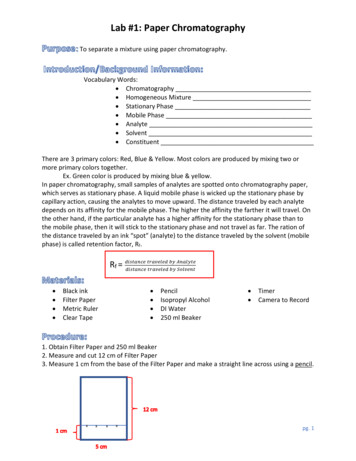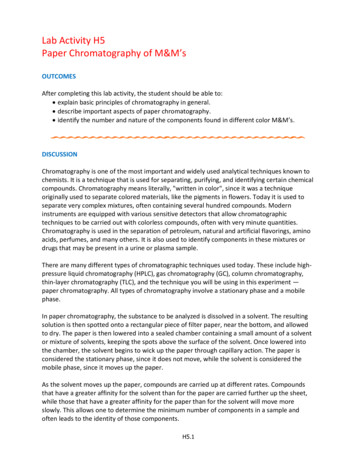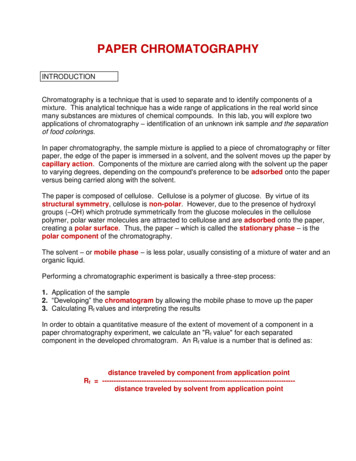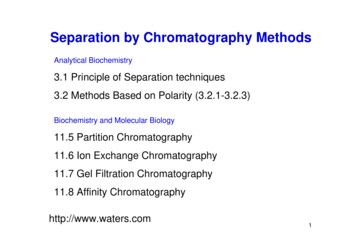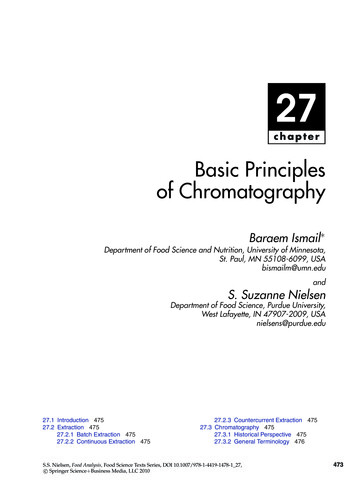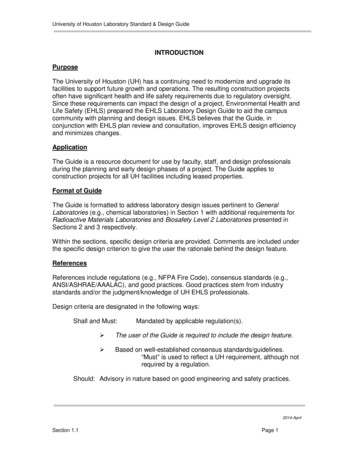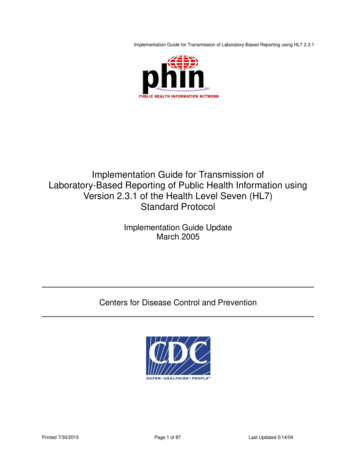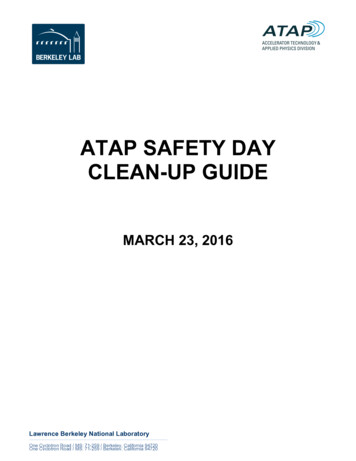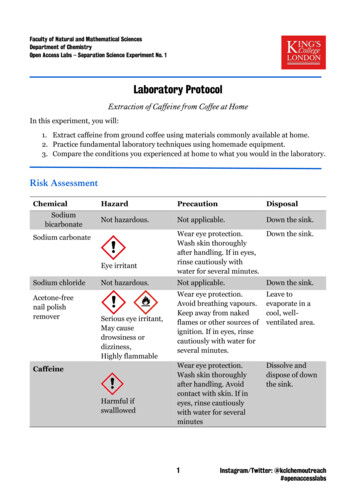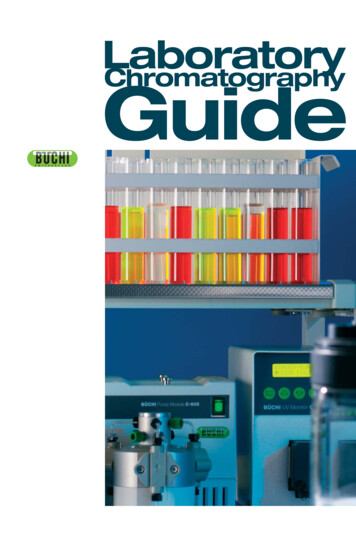
Transcription
LaboratoryChromatographyGuide
LaboratoryChromatographyGuideAngelo Talamona
AuthorPublisherCoverLayoutAngelo TalamonaBüchi Labortechnik AG, CH-9230 Flawil, SwitzerlandNOSE Applied Intelligence AG, CH-8005 Zürich, SwitzerlandAtelier Güttinger AG, CH-9030 Abtwil, SwitzerlandFirst editionPrinted in Switzerland94175 0105All rights reserved. No part of this publication may be reprinted,or reproduced, or utilized in any form or by any electronic ormechanical means – now known or hereafter invented –, includingphotocopying and recording, or in any information storageand retrieval system, without the publisher’s written permission.ISBN 3-033-00339-7 2005 by Büchi Labortechnik AG, CH-9230 Flawil, Switzerland.
“Laboratory Chromatography Guide” – A close look atpreparative liquid chromatographyThe present “Laboratory Chromatography Guide” is dedicated topreparative liquid chromatography, a common purification technique in most chemical or life science laboratories.The performance of separations by chromatography is fairlywell known in the scientific and industrial communities. Part 1, the“Flash Guide Basics”, gives consideration to this fact, proceedingswiftly through flash chromatography with an emphasis on speed,reliability and reproducibility of the separation.But there are no rules without exceptions! As usual, problemsappear with the most exciting and valuable compounds you wantto purify. Therefore, you are personally challenged to understandand solve the purification task as fast as possible. The second part“Preparative Column Chromatography: Theory and Practice” helpsyou to overcome such drawbacks and leads you back to the shiningpath of your privileged profession: to understand and explore whatmodern science offers!We at Buchi, as a leading supplier of high quality laboratory products and responsive services, wish you a lot of challenging andsuccessful work!Dr. Ernst FreydlBüchi Labortechnik AG
ContentsPart 1Flash GuideBasics1Introduction . . . . . . . . . . . . . . . . . . . . . . . . . . . . . . . . .122Principle of chromatography . . . . . . . . . . . . . . . . . . .143Choice of the appropriate stationary phase . . . . . . .154Evaluation of the chromatographic system bythin-layer chromatography . . . . . . . . . . . . . . . .Evaluation of the stationary phase . . . . . . . . . . . . . .Selectivity of the solvent . . . . . . . . . . . . . . . . . . . . .Solvent strength . . . . . . . . . . . . . . . . . . . . . . . . . . .161616185Injection/Column loading . . . . . . . . . . . . . . . . . . . . . .236Gradient elution . . . . . . . . . . . . . . . . . . . . . . . . . . . . . .264.14.24.3.
Part 211.11.21.3Preparative Column ChromatographyTheory and Practice.32323233Fundamentals – The basic principles . . . . . . . . . .General . . . . . . . . . . . . . . . . . . . . . . . . . . . . . . . . . . .Adsorption chromatography . . . . . . . . . . . . . . . . . . . .Separation mechanisms in adsorption chromatographySize exclusion chromatography . . . . . . . . . . . . . . . . . .Ion-exchange chromatography . . . . . . . . . . . . . . . . . .Affinity chromatography . . . . . . . . . . . . . . . . . . . . . . .3434343436393933.13.23.33.43.53.6Stationary phase . . . . . . . .General . . . . . . . . . . . . . . . . .Normal phase silica . . . . . . . .Alumina . . . . . . . . . . . . . . . . .Polyamides . . . . . . . . . . . . . .Reverse phase silica . . . . . . . .Size exclusion bile phase . . . . . . . . . . . . . . . . . . . . . .General . . . . . . . . . . . . . . . . . . . . . . . . . . . .Solvent strength and selectivity . . . . . . . . . . .Purity . . . . . . . . . . . . . . . . . . . . . . . . . . . . . .Solvents for normal phase chromatography . .Solvents for reversed phase chromatographySolvents for gel chromatography . . . . . . . . . .46464749495051Deactivators . . . . . . . . . . . . . . . . . . . . . . . . . . . . . . . . .5366.16.26.3Detection . . . . . . . . . .UV detector . . . . . . . . . .Refractive index detectorConductivity detector . . .5454555677.17.27.37.47.57.67.7Characterizing a column . . . . . . . .The chromatogram . . . . . . . . . . . . . . .Symmetry index . . . . . . . . . . . . . . . . .Number of theoretical plates . . . . . . . .Height equivalent to a theoretical plateReduced plate height . . . . . . . . . . . . .Resolution . . . . . . . . . . . . . . . . . . . . .Dead volume . . . . . . . . . . . . . . . . . . .585859606162626322.12.22.2.12.32.42.55Starting point – Definition of the problemSample . . . . . . . . . . . . . . . . . . . . . . . . . . . . .Purity . . . . . . . . . . . . . . . . . . . . . . . . . . . . . . .Others . . . . . . . . . . . . . . . . . . . . . . . . . . . . . .
Contents88.18.28.38.48.58.68.78.88.98.10Factors affecting chromatographic separation . . . . .Capacity factor k’ . . . . . . . . . . . . . . . . . . . . . . . . . . . . . . .Separation factor α (selectivity factor) . . . . . . . . . . . . . . . .Effect of α and k’ on the resolution . . . . . . . . . . . . . . . . . .Effect of α and k’ on the number of theoretical plates N . . .Effect of particle size on the column efficiency . . . . . . . . . .Effect of flow rate on the column efficiency . . . . . . . . . . . .Effect of column length on the number of theoretical plates .Effect of column length on the resolution . . . . . . . . . . . . . .Chromatography with several columns in series . . . . . . . . .Loading . . . . . . . . . . . . . . . . . . . . . . . . . . . . . . . . . . . . . .99.2.39.3Thin-layer chromatography as a pilot methodfor column chromatography . . . . . . . . . . . . . . . . . . . .Introduction to thin-layer chromatography . . . . . . . . . . . . .Interpretation of TLC information . . . . . . . . . . . . . . . . . . . .Calculation of the Rf value . . . . . . . . . . . . . . . . . . . . . . . .Calculation of the separation factor α, capacity factor k’and plate number N . . . . . . . . . . . . . . . . . . . . . . . . . . . . .Resolution – Relationship of α and N to resolution . . . . . . .Evaluation of stationary and mobile phase by means of TLC10Choice of the appropriate column . . . . . . . . . . . . . . 864666772737476777779808181828283848588Packing and conditioning of the columnGeneral aspects . . . . . . . . . . . . . . . . . . . . . .Dry packing method for glass columns . . . . .Packing method with Büchi Cartridger C-670Slurry packing method for silica . . . . . . . . . .Packing method for soft and rigid gels . . . . .Conditioning dry-packed columns . . . . . . . . .Conditioning slurry-packed columns . . . . . . .Conditioning gel columns . . . . . . . . . . . . . . .898990929394969696Column test . . . . . . . . . . . . . . . . . . . .General aspects . . . . . . . . . . . . . . . . . . .Test mixtures . . . . . . . . . . . . . . . . . . . . .Test mixtures for normal phase columns .Test mixtures for reversed phase columnsTest mixtures for size exclusion gels . . . .Examples of test chromatograms . . . . . .97979898100101101Cleaning of columns . . . . . . . . .Cleaning of normal phase columns .Cleaning of reversed phase columnsCleaning of gel columns . . . . . . . . .10210210310314Equipment description . . . . . . . . . . . . . . . . . . . . . . . .10415Examples . . . . . . . . . . . . . . . . . . . . . . . . . . . . . . . . . . . .3.
Appendix123456Common formulae . . . . . . . . . . . . . . . . .Tables and graphs . . . . . . . . . . . . . . . . .Solvent properties . . . . . . . . . . . . . . . . .Glossary, nomenclature and abbreviationsBibliography . . . . . . . . . . . . . . . . . . . . . .Index . . . . . . . . . . . . . . . . . . . . . . . . . . .AbbreviationsTLCHPLC[C]phase 1GCRPCSiRIS.I.FmV0GLPMPLCLCUVThin-layer chromatographyHigh-performance liquid chromatographyConcentration of the compound C in phase 1Gas chromatographyReversed phase chromatographySolvent strengthRefractive indexSymmetry indexDelivery rateDead volumeGood laboratory practiceMedium pressure liquid chromatographyLiquid chromatographyUltraviolet.110114117120124126
8IntroductionChromatography has developed very rapidly over the past few years. It was a very long way from the first “capillary pictures” ofRunge (1822 –1850) through the early work of Tswett, the discoverer of Adsorption Chromatography (1903, separation of plantpigments) to modern HPLC from about 1967. Tswett had in factadopted the name “Chromatography” for this separation technique(from the Greek chromos colors, graphein write).However, the focal point of this enormous development wasclearly in the area of analysis. In preparative chemistry, on theother hand, chromatographic separations are frequently carriedout even today by a very simple method, i.e. with the aid of asimple glass column under hydrostatic pressure. The first publications on preparative chromatography under elevated pressure,so-called Flash Chromatography, only appeared towards the endof the seventies. This method too was subsequently further refined. This finally resulted in medium pressure liquid chromatography(called MPLC in the following), which is very efficient but nevertheless readily comprehensible and simple to carry out. At the sametime, attempts were made to increase the size of the analyticalHPLC systems and thus make them available also for preparativeor at least semi-preparative work.However, closer scrutiny reveals substantial differences betweenroutine analysis and preparative separation. It is therefore essentialfor a preparative MPLC system to meet the specific requirementsfor such separations. The following factors must be noted in particular:– Flexibility in the choice of column. The amount of substance andthe required separating power differ for virtually every problem tobe solved. Simple and economical adaptation to the particularseparation problem must therefore be possible.– High delivery of the pump. Large columns require large volumeflows so that the desired linear flow rate can be achieved.– Wide pressure range. The trend in preparative chromatographyis clearly towards fine-grained adsorbents, which offer substantial resistance to flow.– The apparatus must be simple to handle. In particular, filling andemptying of the columns as well as operation of the entire remaining system must be capable of being mastered immediatelywithout a prolonged familiarization period. In the preparative laboratory, the liquid chromatography is in general not a specialized unit but rather a universal tool.
9This booklet aims to provide both non-specialists and specialists with short and basic as well as with more detailed explanations of the different procedure steps encountered during a liquidchromatography separation.The first part, “Quick Guide”, is a short, practice-oriented overview of liquid chromatography (LC) for quick reference searchesand the second part provides a broader and deeper description ofthe process, under both practical and theoretical considerations.
Flash GuideBasics1
12Part 1 Flash Guide – Basics1IntroductionChromatography is a standard method used in preparative laboratories to isolate and purify substances. In the early days of chromatography simple glass columns were chiefly used, operated bymeans of the hydrostatic pressure of the solvent acting as an eluent. In a publication in 1978 Clark W. Still explored the possibilityof accelerating the separation process in simple glass columns,which was until then the commonly used method, and therebyconsiderably increasing the efficiency of the technique. The resultswere convincing and the foundations of modern flash chromatography were laid. It triumphantly established itself in laboratoriesas an indispensable purification method in preparative chemistry.Flash chromatography has since undergone constant development,and has been adapted to meet present day expectations in terms ofequipment and convenience.Figure 1:From the simple glasscolumn to modern flashchromatography.Modern flash chromatography systems are popular nowadaysbecause they are simple to handle, flexible and can be universallyemployed. The first part of this brochure aims to give simple, accessible advice, which should ideally instantly lead to effective laboratory elutions.
IntroductionThe following abbreviations are used in the first part:TLCRPNPUVSi%A%BRfCVΔCVRf1Thin-layer chromatographyReversed phase, modified silica gelsNormal phase polar silica gel phasesUltravioletSolvent strength (substitutes polarity)% solvent with low solvent strength% solvent with high solvent strengthRetention factor (from thin-layer chromatograms)Column volumesDifference in column volumesRetention factor of first substance (substance whichspreads onto the TLC plate the quickest. The indexincreases according to the time the substance takes tospread).13
14Part 1 Flash Guide – Basics2Principle of chromatographyChromatographic separation is based on a balanced state amongthe components to be separated, an adsorbent agent in the column( stationary phase) and a solvent flo
“Laboratory Chromatography Guide” – A close look at preparative liquid chromatography The present “Laboratory Chromatography Guide” is dedicated to preparative liquid chromatography, a common purification techni- que in most chemical or life science laboratories. The performance of separations by chromatography is fairly well known in the scientific and industrial communities. Part 1 .
